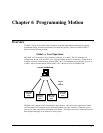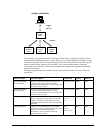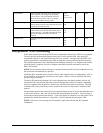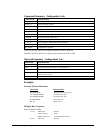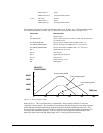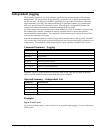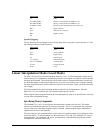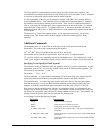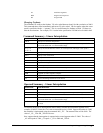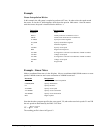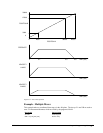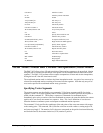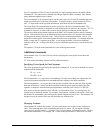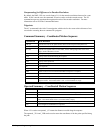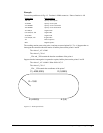
74 • Chapter 6 Programming Motion DMC-3425
The Linear End (LE) command must be used to specify the end of a linear move sequence. This
command tells the controller to decelerate to a stop following the last LI command. If an LE command
is not given, an Abort AB1 must be used to abort the motion sequence.
It is the responsibility of the user to keep enough LI segments in the DMC-3425 sequence buffer to
ensure continuous motion. If the controller receives no additional LI segments and no LE command,
the controller will stop motion instantly at the last vector. There will be no controlled deceleration.
LM? or _LM returns the available spaces for LI segments that can be sent to the buffer. 511 returned
means the buffer is empty and 511 LI segments can be sent. A zero means the buffer is full and no
additional segments can be sent. As long as the buffer is not full, additional LI segments can be sent at
PC bus speeds.
The instruction _CS returns the segment counter. As the segments are processed, _CS increases,
starting at zero. This function allows the host computer to determine which segment is being
processed.
Additional Commands
The commands VS n, VA n, and VD n are used to specify the vector speed, acceleration and
deceleration. The vector speed is computed using the equation:
VS
2
=AS
2
+BS
2
, where AS, and BS are the speed of the A, and B axes.
The controller always uses the axis specifications from LM, not LI, to compute the speed.
VT is used to set the S-curve smoothing constant for coordinated moves. The command AV n is the
‘After Vector’ trippoint, which halts program execution until the vector distance of n has been reached.
Specifying Vector Speed for Each Segment
The instruction VS has an immediate effect and, therefore, must be given at the required time. In some
applications, such as CNC, it is necessary to attach various speeds to different motion segments. This
can be done by two functions: < n and > m
For example: LI x,y < n >m
The first command, < n, is equivalent to commanding VSn at the start of the given segment and will
cause an acceleration toward the new commanded speeds, subjects to the other constraints.
The second function, > m, requires the vector speed to reach the value m at the end of the segment.
Note that the function > m may start the deceleration within the given segment or during previous
segments, as needed to meet the final speed requirement, under the given values of VA and VD.
Note, however, that the controller works with one > m command at a time. As a consequence, one
function may be masked by another. For example, if the function >100000 is followed by >5000, and
the distance for deceleration is not sufficient, the second condition will not be met. The controller will
attempt to lower the speed to 5000, but will reach that at a different point.
As an example, consider the following program.
Instruction
Interpretation
#ALT Label for alternative program
DP 0,0 Define Position of A and B axis to be 0
LMAB Define linear mode between A and B axes.
LI 4000,0 <4000 >1000
Specify first linear segment with a vector speed of 4000 and end
speed 1000
LI 1000,1000 < 4000 >1000
Specify second linear segment with a vector speed of 4000 and end
speed 1000
LI 0,5000 < 4000 >1000
Specify third linear segment with a vector speed of 4000 and end
speed 1000




